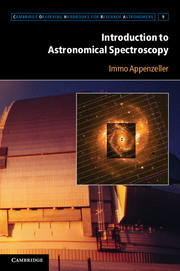Book contents
- Frontmatter
- Contents
- Preface
- 1 Historical Remarks
- 2 Spectroscopy in Present-Day Astronomy
- 3 Basic Physics of Spectral Measurements
- 4 Optical-Range Grating and Prism Spectrometers
- 5 Other Techniques for the Optical Spectral Range
- 6 Preparing and Reducing Optical Observations
- 7 UV, X-Ray, and Gamma Spectroscopy
- 8 Spectroscopy at Radio Wavelengths
- 9 Special Techniques of the FIR and Submillimeter Range
- 10 New Developments and Future Prospects
- Appendix: List of Acronyms
- References
- Index
2 - Spectroscopy in Present-Day Astronomy
Published online by Cambridge University Press: 05 January 2013
- Frontmatter
- Contents
- Preface
- 1 Historical Remarks
- 2 Spectroscopy in Present-Day Astronomy
- 3 Basic Physics of Spectral Measurements
- 4 Optical-Range Grating and Prism Spectrometers
- 5 Other Techniques for the Optical Spectral Range
- 6 Preparing and Reducing Optical Observations
- 7 UV, X-Ray, and Gamma Spectroscopy
- 8 Spectroscopy at Radio Wavelengths
- 9 Special Techniques of the FIR and Submillimeter Range
- 10 New Developments and Future Prospects
- Appendix: List of Acronyms
- References
- Index
Summary
As pointed out in the preface, this book is devoted to the observational and technical aspects of astronomical spectroscopy. Thus, a detailed discussion of the physical analysis and the use of astronomical spectra is outside the scope of this work. On the other hand, some details described in the following chapters can be understood only from the special requirements of astronomical applications. Moreover, many astronomical spectrometers have been designed for specific tasks (although they often turned out to be most useful for other applications, and for work on objects that had not yet been discovered when the instruments were planned). Even spectrometers that are designed to cover a large range of scientific problems usually work best for certain tasks and are less efficient, or totally unsuited, for specific other applications. Therefore, in the following sections, some important applications of astronomical spectroscopy are summarized briefly to provide guidelines for the technical aspects that are described in the later chapters.
Spectral Classification
In many natural sciences, the first step toward an understanding of objects or phenomena has been sorting them into classes according to their observed properties. In astronomy, the first classification occurred when early observers of the night sky started to distinguish between planets and stars on the basis of their different motions. As noted in Chapter 1, during his first spectral observations of stars, Joseph Fraunhofer found significant differences between individual stellar spectra. A first crude classification of the stellar spectra (with four classes) was devised in 1860 by G. B. Donati (1826–1873).
- Type
- Chapter
- Information
- Introduction to Astronomical Spectroscopy , pp. 26 - 49Publisher: Cambridge University PressPrint publication year: 2012



